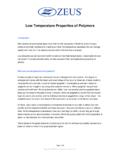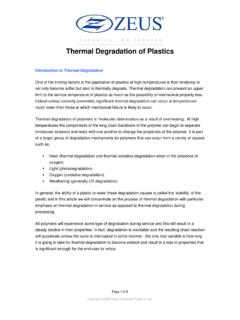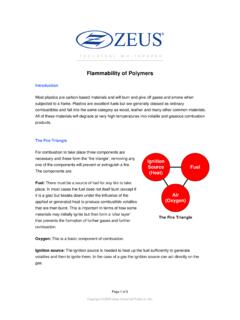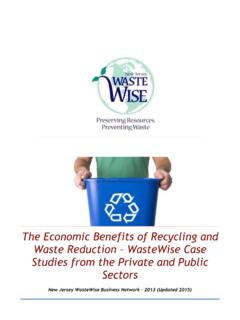Transcription of Economic benefits of rare and endangered species: summary ...
1 ,~ ELSEVIER Ecological Economics 18 (1996) 197-206 ECOLOGICAL ECONOMICS Analysis Economic benefits of rare and endangered species : summary and meta-analysis John B. Loomis *, Douglas S. White Department of Agricultural and Resource Economics, Colorado State University, Fort Collins, CO 80523-1172, USA Received 25 September 1995; accepted 13 February 1996 Abstract The Economic value of rare, threatened and endangered species to citizens of the USA has been measured using the contingent valuation method for 18 different species . Annual willingness to pay (WTP) range from a low of $6 per household for fish such as the striped shiner to a high of $95 per household for the northern spotted owl and its old growth habitat. A regression analysis of WTP values shows that over half of the variation in WTP is explained by the change in the size of the population, whether the payment is one-time or annual, whether the respondent is a visitor or non-user and whether the species is a marine mammal or bird.
2 This illustrates that the contingent valuation method can provide meaningful estimates of the anthropocentric benefits of preserving rare and endangered species , Thus, Economic techniques are available to perform broad-based benefit-cost analyses of species preservation. However, the Safe Minimum Standard approach is offered as an alternative for endangered species preservation decisions. The values reported in this paper are most useful to assess whether the costs are likely to be disproportionate to the benefits . To date, for even the most expensive endangered species preservation effort ( , the northern spotted owl) the costs per household fall well below the benefits per household found in the literature. Keywords: Existence value: Willingness-to-pay; Contingent valuation 1.
3 Introduction The endangered species Act (ESA) is often ridiculed for placing the well-being of fish and wildlife ahead of people. As will be shown in this paper, this is a false dichotomy. The studies in the literature show that people value a wide variety of species from the obscure striped shiner (a fish in the Milwaukee River) to whooping cranes. In re- authorizing ESA, Congress is not only considering * Corresponding author. Tel.: (1-970) 491-2485; Fax: (1-970) 491-2067. 0921-8009/96/$ Published by Elsevier Science PII S0921-8009(96)00029-8 lifting the current prohibition on the use of Economic analysis in the listing process, it may go as far as requiring benefit-cost analysis in the listing deci- sion. This paper provides a discussion of: (1) the types of Economic benefits provided by Threatened and endangered (T&E) species ; (2) the primary technique used to quantify these benefits ; (3) a sum- mary of the Economic valuation studies performed to date, many of which have not been reported in the published literature; (4) a meta-analysis regression to identify the variables which explain the variation in values of T&E species .
4 Based on these analyses we recommend that if Congress requires Economic anal- ysis, one of two approaches would be superior to the 198 Loomis, White~Ecological Economics 18 (1996) 197-206 current practice. First, valuation of multiple T&E species inhabiting the same ecosystems would be more sensible than the current species -by- species approach to valuation. Second, we suggest that an approach called the Safe Minimum Standard (Bi- shop, 1978) may be a better avenue for injecting Economic analysis into re-authorization of ESA than relying on formal benefit-cost analysis. 2. Economic benefits versus impacts To date, most of the Economic analyses per- formed by opponents of species listing and the US Fish and Wildlife Service (in their critical habitat decisions) focus upon the short-run effects on local jobs.
5 While these figures sometimes have significant shock value, rarely is it acknowledged that decreases in commodity production in one region are usually made up by increases in production (and correspond- ing employment gains) in other regions. This type of analysis is frequently called ' Economic impact' or 'regional Economic effects analysis' and often has little to do with the long-run benefits or costs of species preservation. While a transfer of Economic activity is not a cost of protecting T&E species , there are often real opportunity costs to society from protecting T&E species and their habitats in the form of higher costs of production or valuable uses foregone. As such, Economic benefits and costs must be defined and measured in a commensurate fashion.
6 Measuring benefits using willingness to pay (WTP) is the con- ceptually correct measure of benefits (Just et al., 1982) and is the currently accepted norm among federal agencies for benefit-cost analysis (US Water Resources Council, 1983) and Natural Resource Damage Assessment (Department of Interior, 1986). Since the public owns T&E species , willingness to accept for avoiding losses would often be the more appropriate measure. However the public's unfamil- iarity with being offered compensation as compared to being asked to pay for programs, coupled with difficulties in empirical measurement, results in nearly all studies measuring WTP. The reliance on a conservative measure such as WTP may help to offset the concern that the survey technique used to elicit WTP (discussed below) may overstate values since payment is hypothetical.
7 The anthropocentric or human-centered benefits of protecting T&E species can be grouped into several categories: (a) use value such as viewing of the species ; (b) an option value to maintain genetic information provided by populations of T & E species that may be useful for medicinal and genetic engi- neering applications (Loomis, 1995); (c) existence value derived from the satisfaction of knowing that a particular species has a sustainable population in its native habitat; (d) bequest value the current genera- tion receives from knowing preservation today pro- vides this species to future generations. Collectively these benefits are often referred to as Total Eco- nomic Value (Randall and Stoll, 1983). Some or all of these motivations are present when individuals value protection of T&E species .
8 It is also worth noting that while humans may appear to only directly value the 'charismatic megavertabrates', such a valuation may often include implicit valuation for the components of the ecosys- tem that supports these high-profile species . For example, humans may value watching bald eagles yet be unaware or indifferent toward pocket gophers. Yet if pocket gophers are a critical part of the raptors' food supply, then humans have a derived value for the pocket gophers and their habitat. Thus, while an anthropocentric valuation paradigm may seem to ignore many underlying and important eco- logical functions or biocentric values, this may not always be the case. The ecological inter-relationships necessary to support the high-profile species may mean that the entire ecosystem must be protected.
9 3. Contingent valuation method Through various laws, society has declared that T&E species are not commodities to be bought and sold in markets. But these laws suggest that lack of a price for T&E species does not mean lack of value. Therefore economists have developed a hypothetical market method, called the Contingent Valuation Method (CVM), that uses a survey to measure household WTP. A CVM survey involves develop- ing a hypothetical market or referendum which an individual uses to reveal or state his or her WTP for protection of a specific species in a particular loca- tion. The structure of the hypothetical market in- volves three elements: (1) description of the species Loomis, White/Ecological Economics 18 (1996) 197-206 199 and habitat proposed for preservation--this includes location of habitats and specific changes in popula- tion as well as the consequences of paying or not paying; (2) the form and frequency of the payment --for T&E species , common forms include higher income taxes, increases in utility bill and payments into a dedicated trust fund; (3) how they are asked their , as an open-ended question ( , what is the most you would pay?)
10 , circling a dollar amount from a list of alternative figures on a pay- ment card or simply responding 'yes' or 'no' to a single dollar amount (which varies across respon- dents). This latter question format is called 'dichoto- mous choice' or 'referendum' due to its similarity to voting on a bond issue (Hanemann et al., 1991). See Mitchell and Carson (1989) for a complete discus- sion of the CVM methodology. Relying on statements of hypothetical or intended behavior is not without its critics (Diamond and Hausman, 1994). However, CVM has been upheld by the US District Court of Appeals (Department of Interior, 1989) and has been approved for use by federal agencies performing benefit-cost analysis (US Water Resources Council, 1983) along with valuing natural resource damages.













